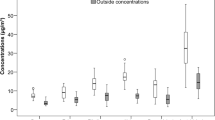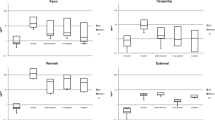Abstract
Benzene, toluene, ethylbenzene, and xylene (BTEX) concentrations were measured in beauty salons (BS) and in the urine of the beauty practitioners and a control group. Indoor and outdoor concentrations of BTEX were measured in 36 randomly selected salons. Before- and after-shift urinary BTEX were measured from one female non-smoker employee in each salon, and repeated three times. Clinical symptoms in that beautician were assessed by a physician. Thirty-six unexposed women were included as the control group. Cancer and non-cancer risks of exposure were assessed using deterministic and stochastic methods. Average indoor concentrations of BTEX were higher than those in the ambient air. Urinary BTEX concentrations in the beauty practitioners were significantly higher than in the control group. Linear regression showed that 77% of urinary benzene and toluene variations can be explained by their airborne concentrations. A positive significant relationship was found between age and urinary BTEX concentrations. Although the BTEX cancer and non-cancer risks were not significant, BTEX led to irritation of the eyes, throat, lung, and nose. In addition, toluene caused menstrual disorders among beauty practitioners. These results suggest that it is essential to decrease the exposure of beauty practitioners to BTEX compounds.

Similar content being viewed by others
References
Abtahi, M., Fakhri, Y., Oliveri Conti, G., Ferrante, M., Taghavi, M., Tavakoli, J., Heshmati, A., Keramati, H., Moradi, B., & Amanidaz, N. J. (2018). The concentration of BTEX in the air of Tehran: a systematic review-meta analysis and risk assessment. International Journal of Environmental Research and Public Health, 15(9), 1837.
ACGIH (2010) TLVs and BEIs based on the documentation of the threshold limit values for chemical substances and physical agents & biological exposure indices. Cincinnati (OH): American Conference of Governmental Industrial Hygienists.
Alaves, V. M., Sleeth, D. K., Thiese, M. S., & Larson, R. R. (2013). Characterization of indoor air contaminants in a randomly selected set of commercial nail salons in Salt Lake County, Utah, USA. International Journal of Environmental Health Research, 23(5), 419–433.
Arnold, S. M., Angerer, J., Boogaard, P. J., Hughes, M. F., O'Lone, R. B., Robison, S. H., & Schnatter, A. R. (2013). The use of biomonitoring data in exposure and human health risk assessment: benzene case study. Critical Reviews in Toxicology, 43(2), 119–153. https://doi.org/10.3109/10408444.2012.756455.
Asl, F. B., Leili, M., Vaziri, Y., Arian, S. S., Cristaldi, A., Conti, G. O., & Ferrante, M. J. (2018). Health impacts quantification of ambient air pollutants using AirQ model approach in Hamadan Iran. Environmental Research, 161, 114–121.
Batterman, S., Jia, C., & Hatzivasilis, G. (2007). Migration of volatile organic compounds from attached garages to residences: a major exposure source. Environmental Research, 104(2), 224–240.
Choi, S. W., Park, S. W., Lee, C. S., Kim, H. J., Bae, S., & Inyang, H. I. (2009). Patterns of VOC and BTEX concentration in ambient air around industrial sources in Daegu, Korea. Journal of Environmental Science and Health, Part A, 44(1), 99–107.
Czene, K., Tiikkaja, S., & Hemminki, K. (2003). Cancer risks in hairdressers: assessment of carcinogenicity of hair dyes and gels. International Journal of Cancer, 105(1), 108–112.
Dehghani, M., Keshtgar, L., Javaheri, M. R., Derakhshan, Z., Oliveri Conti, G., Zuccarello, P., & Ferrante, M. J. (2017). The effects of air pollutants on the mortality rate of lung cancer and leukemia. Molecular Medicine Reports, 15(5), 3390–3397.
Ekpenyong, C. E., Davies, K., & Daniel, N. (2013). Effects of gasoline inhalation on menstrual characteristics and the hormonal profile of female petrol pump workers. Journal of Environmental Protection, 4(08), 65–73.
Eller, P. M., & Cassinelli, M. E. (1994). NIOSH manual of analytical methods. United States: National Institute for Occupational Safety and Health.
Galiotte, M. P., Kohler, P., Mussi, G., & Figaro Gattás, G. J. (2008). Assessment of occupational genotoxic risk among Brazilian hairdressers. Annals of Occupational Hygiene, 52(7), 645–651.
Goldin, L. J., Ansher, L., Berlin, A., Cheng, J., Kanopkin, D., Khazan, A., Kisivuli, M., Lortie, M., Peterson, E. B., & Pohl, L. (2014). Indoor air quality survey of nail salons in Boston. Journal of Immigrant and Minority Health, 16(3), 508–514.
Grešner, P., Stepnik, M., Król, M. B., Swiercz, R., Smok-Pieniazek, A., Twardowska, E., Gromadzinska, J., & Wasowicz, W. (2015). Dysregulation of markers of oxidative stress and DNA damage among nail technicians despite low exposure to volatile organic compounds. Scandinavian Journal of Work, Environment & Health, 41(6), 579–593.
Guo, H., Lee, S., Li, W., & Cao, J. (2003). Source characterization of BTEX in indoor microenvironments in Hong Kong. Atmospheric Environment, 37(1), 73–82.
Hadei, M., Hopke, P. K., Rafiee, M., Rastkari, N., Yarahmadi, M., Kermani, M., & Shahsavani, A. (2018a). Indoor and outdoor concentrations of BTEX and formaldehyde in Tehran, Iran: effects of building characteristics and health risk assessment. Environmental Science and Pollution Research, 25(27), 27423–27437. https://doi.org/10.1007/s11356-018-2794-4.
Hadei, M., Hopke, P. K., Shahsavani, A., Moradi, M., Yarahmadi, M., Emam, B., & Rastkari, N. (2018b). Indoor concentrations of VOCs in beauty salons; association with cosmetic practices and health risk assessment. Journal of Occupational Medicine and Toxicology, 13(1), 30.
Halliday-Bell, J. A., Gissler, M., & Jaakkola, J. J. (2009). Work as a hairdresser and cosmetologist and adverse pregnancy outcomes. Occupational Medicine, 59(3), 180–184.
Hamid, H. H. A., Jumah, N. S., Latif, M. T., & Kannan, N. (2017). BTEXs in indoor and outdoor air samples: source apportionment and health risk assessment of benzene. Journal of Environmental Sciences, 1(1), 49–56.
Kitwattanavong, M., Prueksasit, T., Morknoy, D., Tunsaringkarn, T., & Siriwong, W. (2010) Inhalation exposure to carbonyl compounds and BTEX and health risk assessment of gas station workers in the inner city of Bangkok. In Proceedings of the 42nd Asia-pacific Academic Consortium for Public Health (APACPH) Conference on Strengthening Public Health Institutions to Address Non Communicable Diseases and Emerging Health Challenges, (pp. 24–27).
Labrèche, F., Forest, J., Trottier, M., Lalonde, M., & Simard, R. (2003). Characterization of chemical exposures in hairdressing salons. Applied Occupational and Environmental Hygiene, 18(12), 1014–1021.
Leino, T. (1999). Working conditions and health in hairdressing salons. Applied Occupational and Environmental Hygiene, 14(1), 26–33.
Leino, T., Tammilehto, L., & Hytonen, M. (1999). Occupational skin and respiratory diseases among hairdressers. Occupational Health and Industrial Medicine, 2(40), 88–98.
Masih, A., Lall, A. S., Taneja, A., & Singhvi, R. (2017). Exposure profiles, seasonal variation and health risk assessment of BTEX in indoor air of homes at different microenvironments of a terai province of northern India. Chemosphere, 176, 8–17.
Nathanson, T. (1995). Indoor air quality in office buildings: a technical guide. Canada: Federal-Provincial Advisory Committee on Environmental and Occupational Health, Health Canada.
Nicolopoulou-Stamati, P., & Pitsos, M. (2001). The impact of endocrine disrupters on the female reproductive system. Human Reproduction Update, 7(3), 323–330.
NIOSH (2007). Niosh pocket guide to chemical hazards. United States: US Department of Health and Human Services.
Quach, T., Gunier, R., Tran, A., Von Behren, J., Doan-Billings, P.-A., Nguyen, K.-D., Okahara, L., Lui, B. Y.-B., Nguyen, M., & Huynh, J. (2011). Characterizing workplace exposures in Vietnamese women working in California nail salons. American Journal of Public Health, 101(S1), S271–S276.
Ramírez, N., Cuadras, A., Rovira, E., Borrull, F., & Marcé, R. M. (2012). Chronic risk assessment of exposure to volatile organic compounds in the atmosphere near the largest Mediterranean industrial site. Environment International, 39(1), 200–209.
Robson, M. G., & Toscano, W. A. (2007). Risk assessment for environmental health (Vol. 2). United States: John Wiley & Sons.
Ronda, E., Hollund, B. E., & Moen, B. E. (2009). Airborne exposure to chemical substances in hairdresser salons. Environmental Monitoring and Assessment, 153(1), 83–93.
Song, H. N., Kim, C. H., Lee, W. Y., & Cho, S. H. (2017). Simultaneous determination of volatile organic compounds with a wide range of polarities in urine by headspace solid-phase microextraction coupled to gas chromatography/mass spectrometry. Rapid Communications in Mass Spectrometry, 31(7), 613–622. https://doi.org/10.1002/rcm.7827.
Tsigonia, A., Lagoudi, A., Chandrinou, S., Linos, A., Evlogias, N., & Alexopoulos, E. C. (2010). Indoor air in beauty salons and occupational health exposure of cosmetologists to chemical substances. International Journal of Environmental Research and Public Health, 7(1), 314–324.
Tunsaringkarn, T., Siriwong, W., Rungsiyothin, A., & Nopparatbundit, S. (2012). Occupational exposure of gasoline station workers to BTEX compounds in Bangkok, Thailand. The International Journal of Occupational and Environmental Medicine, 3(3), 117–125.
US EPA (1989). Risk assessment guidance for superfund. Volume I: Human health evaluation manual. United States: US Enivornment Protection Agency
WHO. (2010). WHO guidelines for indoor air quality: selected pollutants. Switzerland: World Health Organization.
Wiwanitkit, V. (2008). Headaches in subjects occupationally exposed to benzene vapors. The Journal of Headache and Pain, 9(4), 253–254.
Yang, J. H., Kim, J. Y., Eom, A., Hyoung, H. K., & Koh, S. B. (2010). Relationships between airborne exposure and urinary metabolites of nail technicians. Toxicology and Environmental Health Sciences, 2(3), 175–181.
Funding
This study was has supported by grant numbers#10856 from Shahid Beheshti University of Medical Sciences.
Author information
Authors and Affiliations
Corresponding author
Ethics declarations
Competing interests
The authors declare that they have no competing interests.
Additional information
Publisher’s note
Springer Nature remains neutral with regard to jurisdictional claims in published maps and institutional affiliations.
Electronic supplementary material
ESM 1
(DOCX 17 kb)
Rights and permissions
About this article
Cite this article
Moradi, M., Hopke, P., Hadei, M. et al. Exposure to BTEX in beauty salons: biomonitoring, urinary excretion, clinical symptoms, and health risk assessments. Environ Monit Assess 191, 286 (2019). https://doi.org/10.1007/s10661-019-7455-7
Received:
Accepted:
Published:
DOI: https://doi.org/10.1007/s10661-019-7455-7




